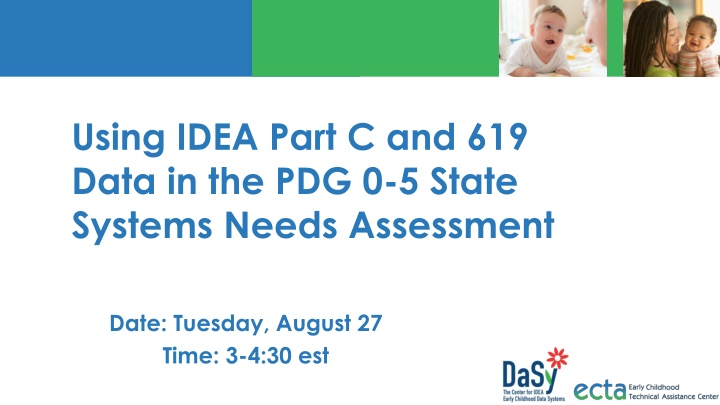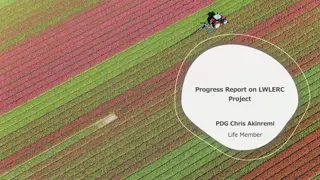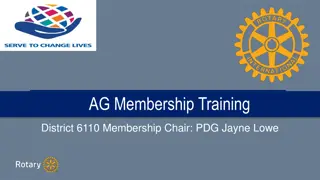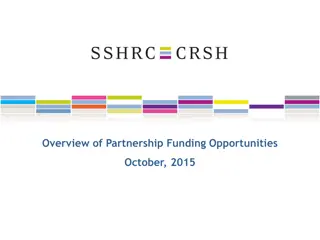
Utilizing IDEA Part C and 619 Data for State Systems Needs Assessment
Explore how IDEA Part C and 619 data can inform the PDG 0-5 state systems needs assessment. Learn about the types of data collected, where to find it, and how to analyze it effectively for decision-making. Discover state examples of utilizing this data. Presented by experts in the field to support state PDG managers in developing a comprehensive approach to their needs assessment.
Download Presentation

Please find below an Image/Link to download the presentation.
The content on the website is provided AS IS for your information and personal use only. It may not be sold, licensed, or shared on other websites without obtaining consent from the author. If you encounter any issues during the download, it is possible that the publisher has removed the file from their server.
You are allowed to download the files provided on this website for personal or commercial use, subject to the condition that they are used lawfully. All files are the property of their respective owners.
The content on the website is provided AS IS for your information and personal use only. It may not be sold, licensed, or shared on other websites without obtaining consent from the author.
E N D
Presentation Transcript
Using IDEA Part C and 619 Data in the PDG 0-5 State Systems Needs Assessment Date: Tuesday, August 27 Time: 3-4:30 est
Partners and Presenters Kathleen Hebbeler, DaSY Christina Kazprzak, ECTA Grace Kelley, DaSY Haidee Bernstein, DaSY Jim Lesko, PDGB-5 State Presenters: Debra Anderson, Ginger Elliot-Teague & Jackie Adusumilli Presented by: DaSy, ECTA & PDG B-5 TA.
Purpose Support state PDG managers in taking a comprehensive approach to develop the needs assessment which will inform the strategic plan by Sharing information about the IDEA Part C and Part B 619 data Highlighting types of data collected and where the data is located Sharing state examples of how the data can be used and analyzed for effective decision-making
Overview of the IDEA Requirements IDEA Part C contains the reporting requirements for eligible infants and toddlers with disabilities ages birth to 3 and their families. There are 10 Annual Performance Reports (APRs) Indicators and 1 State Systemic Improvement Plan (SSIP) IDEA Part B contains the reporting requirements for eligible children with disabilities ages 3-21. There are 14 APR Indicators and 1 SSIP. 4
Relevant Part C Indicators Child Count Birth to 1 Birth to 3 Percent of birth to 3 served (state and national level) By race/ethnicity By race and by settings Child Outcomes Positive social emotional skills Acquisition and use of knowledge and skills Use of appropriate behavior to meet needs 5
Relevant Part C Indicators Family Outcomes: The percent of families served who: Know their rights Effectively communicate their child s needs Help their child develop and learn Percent of infants and toddlers primarily served at home or in the community 6
Percentage of Children Served from Birth to Age Five (N=36,664) by Race/Ethnicity for Hypothetical State 100% 50% (18,250) 25% (9,250) 12% (4,500) 5% 4% 2% (750) 2% (630) (1,764) (1,500) 0% American Indian or Alaska Native Native Hawaiian or Other Pacific Islander Asian Two or More Races Hispanic/Latino Black or African American White
Question: What percentage of children referred are enrolled in EI services? 8
Question How many children who are referred, receive services and transition to preschool special education programs ? 10
North Dakota Part C and PDG Our experience with IDEA Data, Part C Stakeholders and the Preschool Development Grant
Part C Involvement North Dakota Office Of Early Learning (OEL) Department of Public Instruction (DPI) Part B 619 Head Start Collaboration Administrator OEL Director and Assistant Director Department of Human Services (DHS) Part C Coordinator Child Care Administrator This Photo by Unknown Author is licensed under CC BY-SA-NC
Part C Involvement Involved in grant writing process Contributed information about Part C s needs in all areas, including SSIP Directed specific grant activities related to Part C Helped to determine overall OEL goals and outcomes Collaborating with OEL to work toward goals during this grant period This Photo by Unknown Author is licensed under CC BY-NC-ND
Part C Involvement Needs Assessment Part C/618 Data- demographics from most recent APR Feedback from ICC What information are we missing? Where can we get that information? Who else do we need to talk to? Feedback from Part C Parents Transition focus groups and surveys Child Care focus groups This Photo by Unknown Author is licensed under CC BY-SA
Next Steps Follow-up with ICC and other Part C Stakeholders Integrated Data System Pulling together other 0-3 state programs (EHDI, Home Visiting Programs, etc.) Next Grant Cycle Will remain involved with writing Building off of current goals and program needs
Relevant IDEA Preschool Data Preschool settings: Percent of Children ages 3-5 attending: Regular early childhood program and receiving the majority of their special education services in a regular early childhood program Separate special education class, separate school or residential facility Child Outcomes Positive social emotional skills Acquisition and use of knowledge and skills Use of appropriate behavior to meet needs 17
Relevant IDEA Preschool Data Transition to Preschool: The percent of children referred by Part C prior to age 3 who are found eligible for Part B and have an IEP developed and implemented by Part B by their third birthday Parent Involvement: The percent of parents with a child with disabilities age 3-5 who report that schools facilitated parent involvement 18
Relevant IDEA Preschool Data Child Count age 3-5 Percent of children aged 3-5 served (state and national level) By race/ethnicity By race and by educational settings 19
Question How many children transition directly or indirectly from EI(Part C)to preschool special education (619)? How many children have not received EI services but enter preschool special education (619)? 20
Sample Bar Graph on Preschool Special Education Children age 3-5 Receiving Special Education Services 1600 1400 1200 800 1000 800 600 375 375 400 200 250 250 0 EI to ECSE All Kids in ECSE transitioned directly from EI did not transition directly from EI Never in EI 21
State Systemic Improvement Plan (SSIP) In 2015, states were required to develop 2 SSIPS. They are an achievable multi-year plan to improve results for: (1) improving results for infants and toddlers with disabilities and their families and (2) improving results for children ages 3-21 with disabilities In the first year (Phase 1), states were required to submit: Data Analyses (includes child counts and child outcome data related to the work they want to accomplish) Analyses of the state infrastructure to support improvement and build capacity State identified Measurable results for children with disabilities Selection of Improvement strategies Theory of Action 22
State Systemic Improvement Plan (SSIP) Phase II (2016) required states to: Develop the infrastructure needed to support their improvement strategies Support local education agencies implementation of evidence-based practices Conduct evaluations of progress Phase III (2017- now) Continue implementation of strategies and report progress 23
Development of Oklahomas ECIDS* How SoonerStart (Part C) data became the first step in linking data Dream big 10 year journey Focus on one identifiable action Link to existing efforts DISCUSS (Interagency body to create data system interoperability) Unique Identifier (Master Person Index) W.K. Kellogg Foundation and George Kaiser Family Foundation Project SHINE *Early Childhood Integrated Data System
What Did We Want to Know? Created several research questions about enrollment in HV programs and how that might impact later outcomes and which children are enrolled in programs in addition to HV The MIECHV program identified a reason to link with SoonerStart to answer one performance measure Do children enrolled in HV programs who are referred to SoonerStart receive an assessment within 45 days of the referral?
Opportunities and Challenges The Master Person Index analytics had been completed on both sets of data. Part C and MIECHV services are both administered through the Department of Health, providing the opportunity for data managers within the same agency to create and manage data linkages. Even though they are in the same agency, their data systems do not automatically link. Department of Education is the lead agency for SoonerStart which required legal counsel from two state agencies needed to agree and approve this data linkage.
Project SHINE State-level Home Visiting Integration with Early Childhood Data Systems (SHINE) initiative. Oklahoma one of five states Goal in ensure the HV data is integrated into state level early childhood data systems Oklahoma s objective was to create a schedule in the existing interagency data sharing agreement to link HV data
Results and Benefits A total of 163 records matched 35 received an initial assessment with SoonerStart within the 0-45 day window 118 of them had actually received an initial assessment prior to the ASQ-3 being administered by the Home Visitor Ability to match these records increase in accuracy of the data Reduced burden for the providers to remember to enter the data, so they can focus on service provision
Future Questions under development The extent to which constrained supply and restrictive eligibility requirements limit access to Part B/C services. How these issues might differ across regions and/or populations. Help Oklahoma understand which factors drive the significant number of SoonerStart referrals that do not lead to service in order to increase its ability to serve children with developmental delays and ensure continuity of care.
Links Current Part C and Preschool Coordinator Contacts for each state: http://ectacenter.org/contact/ptccoord.asp Office of Special education Indicator Analyses: https://osep.grads360.org/#program State Performance Plan (SPP)/ Annual Performance Plan (APP): https://osep.grads360.org/#report/apr/publicView Annual Report to Congress: https://www2.ed.gov/about/reports/annual/osep/2018/parts-b-c/40th-arc-for- idea.pdf 31
Links Critical Questions about EI/ECSE https://dasycenter.sri.com/downloads/DaSy_papers/DaSy_Critical_Questions_FINAL_20151023v2.pdf 32
Final presentation slide Visit the DaSy website at: http://dasycenter.org/ Follow DaSy on Twitter: @DaSyCenter Visit the ECTA website at: http://ectacenter.org/ Follow ECTA on Twitter: @ECTACenter 33
Thank you The contents of this tool and guidance were developed under grants from the U.S. Department of Education, #H373Z120002 and #H326P170001. However, those contents do not necessarily represent the policy of the U.S. Department of Education, and you should not assume endorsement by the Federal Government. Project Officers: Meredith Miceli, Richelle Davis, and Julia Martin Eile. 34





















